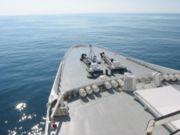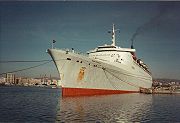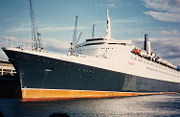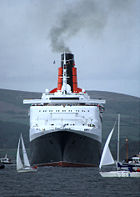RMS Queen Elizabeth 2
2008/9 Schools Wikipedia Selection. Related subjects: Air & Sea transport
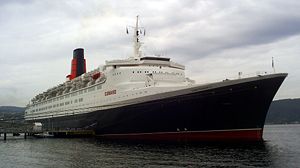 RMS Queen Elizabeth 2 in Norway, June 2006 |
|
| Career | |
|---|---|
| Name: | RMS Queen Elizabeth 2 |
| Owner: | Carnival Corporation & plc |
| Operator: | Cunard Line |
| Port of Registry: | Southampton |
| Ordered: | 1964 |
| Builder: | John Brown and Company, Clydebank, Scotland |
| Cost: | £29,091,000 |
| Laid down: | July 5, 1965 |
| Launched: | September 20, 1967 |
| Christened: | September 20, 1967 by Queen Elizabeth II |
| Maiden voyage: | May 2, 1969 |
| Out of service: | November 2008 (planned) |
| Status: | In Service |
| General characteristics | |
| Tonnage: | 70,327 gross tonnes |
| Displacement: | 48,923 (loaded) |
| Length: | 293.5 m (963 ft) |
| Beam: | 32.03 m (105 ft) |
| Height: | 52.2 m (171 ft 4 in) |
| Draft: | 9.87 m (32 ft) |
| Installed power: | 9 x 10,625 kW at 400 rpm |
| Propulsion: | 9 MAN 9-cylinder medium speed turbo-charged diesel engines turning two five-bladed variable pitch propellers |
| Speed: | 34 knots (62 km/h), 20 knots (37 km/h) going astern (figures recorded during sea trials post powerplant replacement). |
| Capacity: | 1,756 passengers 1,892 (all berths) passengers |
| Crew: | 1,015 officers and crew |
RMS Queen Elizabeth 2 (QE2) is a Cunard Line ocean liner named after the earlier Cunard liner RMS Queen Elizabeth, which in turn was named after Elizabeth Bowes-Lyon, the Queen consort of George VI. She was the flagship of the line from 1969 until succeeded by RMS Queen Mary 2 in 2004. Built in Clydebank, Scotland, she was considered the last of the great transatlantic ocean liners prior to the construction of the QM2. Before she was refitted with a diesel power plant in 1986, she was also the last oil-fired passenger steamship to cross the Atlantic in scheduled liner service. During almost 40 years of service, the QE2 has travelled the world and now operates predominantly as a cruise ship, sailing out of Southampton, England. She will be retired from active service in late 2008, to become a floating hotel at Palm Jumeirah, Dubai.
Characteristics
The ship measures 70,327 gross tons and is 963 ft (294 m) long. She had a top speed of 32.5 knots using her original steam turbine powerplant, which was raised to 34 knots when she was re-engined with a diesel electric powerplant, making her one of the fastest passenger ships afloat.
Contrary to what commonly occurred in previous decades where shipping lines would construct ever larger flagships, the QE2 was built smaller than her predecessor RMS Queen Elizabeth, as Cunard realised passenger demand was no longer as great, fuel was increasingly expensive, and she needed the ability to pass through the Panama Canal. Her successor, Queen Mary 2, built almost 40 years later, is approximately twice the size and 200 feet longer than QE2. The older ship can carry approximately 1,700 passengers and 1,015 crew members, for a total of approximately 2,715 people on board.
The QE2 was not named after Queen Elizabeth II, who launched her in 1969, but after the previous Queen Elizabeth, which in turn was named for the Queen Mother. Thus, as Roman numerals are always used for monarchs, the Arabic numeral "2" is used in the ship's name to distinguish her from the monarch, Queen Elizabeth II. Further, when Queen Elizabeth II launched the ship in 1967 she referred to it as "Queen Elizabeth the Second"; however, the ship is normally called "Queen Elizabeth Two," not "The Second", for the same reason.
History
Concept and construction
By the mid 1960s transatlantic travel was dominated by air travel due to its speed and inexpensive cost relative to the sea route, and expansion of air travel showed no signs of slowing down. Conversely, the Queen Mary and Queen Elizabeth were becoming expensive to operate, and both internally and externally were relics of the pre-war years. However, Cunard did not want to give up the business of passenger service, and so gambled $80 million on a new ocean liner to replace the original "Queens," as well as to compete with the French Line's recently built SS France.
Realising the decline of transatlantic trade, Cunard decided their new ship was to be smaller and cheaper to operate than her predecessors. Originally designated "Q4" (a previous ship "Q3" had been abandoned due to falling passenger revenues on the North Atlantic), she was to be a three-class liner, larger than her predecessors. However, looking to the France, designs were changed to make "Q4" a two-class liner that could be modified into a single-class cruise ship, thereby allowing the ship to ply the Atlantic during the peak summer season, as well as warmer waters during the winter.
The Queen Elizabeth 2 was built by the Upper Clyde Shipbuilders in the John Brown Shipyard in Clydebank, Scotland. Her keel was laid down on July 5, 1965 and she was launched on September 20, 1967, by Queen Elizabeth II, using the pair of gold scissors used by her mother and grandmother to launch the Queen Elizabeth and Queen Mary respectively.
In 1986 the ship was sent to Lloyd Werft Shipyard in Bremerhaven to have her steam turbine powerplant replaced by a diesel electric powerplant and variable pitch propellers - This reduced the fuel consumption by half and improved the operating performance. This refit took the ship out of service for six months, and cost Cunard $162 million, not including lost revenue. At this time her funnel was replaced by a wider one in order to accommodate the exhaust pipes for the nine B&W medium speed diesel engines.
Service history
The Queen Elizabeth 2's maiden voyage, from Southampton to New York City, commenced on May 2, 1969, taking 4 days, 16 hours and 35 minutes. However, Prince Charles was the first "civilian" passenger to board the ship, on her voyage from the shipyard in Clydebank to drydock in Greenock.
In 1970 she set a record in crossing the Atlantic in 3 days, 20 hours and 42 minutes, an average speed of 30.36 knots. The following year she participated in the rescue of some 500 passengers from the burning French Line ship Antilles.
On May 17, 1972, while travelling from New York to Southampton, she was the subject of a bomb threat. She was searched by her crew, and a bomb disposal team parachuted into the sea near the ship. No bomb was found, but the hoaxer was arrested by the FBI. This incident went on to inspire the 1974 Richard Lester feature film Juggernaut. The following year the QE2 undertook two chartered cruises through the Mediterranean to Israel in commemoration of the 25th anniversary of the state's founding. One kitchen on the ship was koshered for Passover, and Jewish people celebrated Passover on the ship. Later, on July 16, 1974, Egyptian President Anwar Sadat revealed in a television interview that Libyan President Muammar al-Qaddafi had ordered an Egyptian submarine to torpedo the QE2 during the cruise. Sadat said he had personally countermanded the order.
In 1982, she took part in the Falklands War, carrying 3,000 troops and 650 volunteer crew to the south Atlantic. She was refitted in Southampton in preparation for war service, including the installation of three helicopter pads, the transformation of public lounges into dormitories, fuel pipes run through the ship down to the engine room to allow for refuelling at sea, and the covering of carpets with 2,000 sheets of hardboard. Over 650 Cunard crewmembers volunteered for the voyage to look after the 3,000 members of the Fifth Infantry Brigade, which the ship transported to South Georgia. During the voyage the ship was blacked out and the radar switched off in order to avoid detection, steaming on without modern aids. That same year she returned to the UK, being welcomed by Queen Elizabeth, the Queen Mother on board the Royal Yacht Britannia. The Captain of the QE2 responded to the Queen Mother's welcome: "Please convey to Her Majesty Queen Elizabeth, the Queen Mother, our thanks for her kind message. Cunard's Queen Elizabeth 2 is proud to have been of service to Her Majesty's Forces." The ship underwent conversion back to passenger service, with her funnel being painted in the traditional Cunard orange-red with black stripes, but her hull painted an unconventional light charcoal grey. This colour proved hard to maintain, and so was reverted to traditional colours in 1983.
In August 1992, her hull was damaged when she ran aground off Cuttyhunk Island near Cape Cod, while returning from a five day cruise to Halifax, Nova Scotia along the east coast of the United States and Canada. A combination of outdated charts and faster than normal speed (proportional to the distance from the coast, only 20-30 miles) led to the ship's hull scraping a rock on the ocean floor. The accident resulted in the ship being taken out of service while repairs were made in drydock. Several years later, divers found red paint on rocks in the vicinity of where the ship was said to have hit bottom.
In 1995, she encountered a freak wave, estimated at 29 m (95 ft), caused by Hurricane Luis in the North Atlantic Ocean. One year later, during her twentieth world cruise, she passed her four millionth mile mark. The ship had sailed the equivalent of 185 times around the planet.
The QE2 celebrated the 30th anniversary of her maiden voyage in Southampton in 1999. In three decades she had 1,159 voyages, sailed 4,648,050 nautical miles (5,347,018 mi, 8,605,209 km) and carried over 2 million passengers.
Over the months of November and December 2001 the QE2 was given a major refurbishment, with new carpets and furnishing throughout many cabins and public rooms, as well as minor changes to layout, such as on the upper level of the Grand Lounge.

While she has been taken off the traditional "transatlantic" route, which was taken over by the Queen Mary 2 in 2005, the QE2 still undertakes an annual world cruise and regular trips around the Mediterranean. At the end of her 2005 world cruise, certain pieces of her artwork were damaged when some crew members who had become inebriated at an onboard crew party, went on a vandalism rampage through the public areas of the ship. A "priceless" tapestry of Queen Elizabeth II, commissioned for the launch of the ship, was thrown overboard. Further, an oil painting of the QE2 and two other tapestries were damaged, along with a part of the entertainment area and a lifeboat. The crew were dismissed from service with charges pending.
On November 5, 2004, the QE2 became Cunard's longest serving ship, surpassing the RMS Aquitania's 35 years.

On February 20, 2007, the QE2, while on her annual world cruise, met her running mate and successor flagship QM2 (herself on her maiden world cruise) in Sydney Harbour, Australia. This was the first time two Cunard Queens had been together in Sydney since the original Queen Mary and Queen Elizabeth served as troop ships in 1941.
As of September, 2007, the QE2 has travelled 5.6 million nautical miles, including 25 circumnavigations of the globe, 801 transatlantic crossings, 705 calls at New York, and 697 at Southampton. 2.5 million passengers have sailed on the ship.
Retirement
As the Queen Elizabeth 2 approached her 40th anniversary in service, there was speculation over her future. This was heightened when Cunard ordered a new cruise ship, MS Queen Victoria, which began sailing on December 11, 2007. The company also had to consider the economics of maintaining a 40-year-old liner in operation, particularly with regard to new SOLAS safety regulations that would apply from 2010 onward, requiring major structural works.
Both Southampton and Clydebank had offered to take over QE2 after her retirement, but on 18 June 2007, it was announced that she is to be purchased by the Dubai government investment company Istithmar for $100 million. Her final voyage will be from Southampton to Dubai, leaving on 11 November 2008. After arrival, she will be refurbished and berthed permanently at the Palm Jumeirah from 2009 as a "a luxury floating hotel, retail, museum and entertainment destination." It has been reported that the refurbishments will see the restoration of the QE2's original 1960s decor.
In a ceremonial display before her retirement, the QE2 met the Queen Victoria and the Queen Mary 2 near the Statue of Liberty in New York City harbour on January 13, 2008, with a celebratory fireworks display; the QE2 and QV had made a tandem crossing of the Atlantic for the meet. This marked the first time three Cunard Queens have been present in the same location, and Cunard stated this will be the last time these three particular ships will meet, due to the impending retirement of the QE2.
Design
Exterior
Cunard's last major liner, the RMS Queen Elizabeth, when completed in 1940 was even then considered of an outmoded design, despite some alterations to her overall design which made her sleeker than her sister ship, the Queen Mary. This was especially noticeable when she was compared to French liners like the SS Normandie, built in 1935, and later the SS France, completed in 1962. So, when designing the Queen Elizabeth 2, during difficult times when other ships were being laid up or sent to the scrapyards, Cunard wanted her to be modern and reflective of 1960s Britain, as well as featuring the most modern advancements in maritime design.
Like both the Normandie and France, the QE2 has a bulbous bow, flared stem, and clean forecastle. One innovation that made her distinct from all other ships is her funnel, which bears at its base an upward turned wind scoop that uses the forward motion of the ship to push air directly up the flanks of the funnel to catch the exhaust and disperse it far above the aft passenger decks. What was controversial at the time was that Cunard decided not to paint the funnel with the line's distinctive colour and pattern, something that had been done on all merchant vessels since the first Cunard ship, the RMS Britannia, sailed in 1840. Instead the funnel was painted white and black, with the Cunard orange-red appearing only on the inside of the wind scoop. This practice ended in 1983 when the QE2 returned from service in the Falklands War, and the funnel has been painted in Cunard orange-red with black horizontal bands (correctly known as "hands") ever since. The original pencil-like funnel was replaced in 1986 with a more robust one, when the ship was converted from steam to diesel power.
Large amounts of aluminium were used in the framing and cladding of the QE2's superstructure. This reduced weight, and therefore fuel consumption, but also posed problems with joining the aluminium to the steel hull, as with the SS United States. The low melting point of aluminium caused concern when the QE2 was serving as a troop ship during the Falklands War: some feared that if the ship were struck by a missile, as was HMS Sheffield, her upper decks would collapse quickly due to fire, thereby causing greater casualties.
In 1972, two penthouse suites were added in an aluminium structure on the Signal Deck, behind the ship's bridge, and in 1977 this structure was expanded to include more suites with balconies, making the QE2 one of the first ships to offer private terraces to passengers since the SS Normandie in the 1930's, whose balconies were hidden in what would have been her promenade deck.
Interior
The Queen Elizabeth 2's interior configuration was laid out in a horizontal fashion, similar to the SS France, where the spaces dedicated to the two classes were spread horizontally on specific decks, in contrast to the vertical class divisions of older liners. Where the QE2 differed from the France was that the first class deck (Quarter Deck) was below the deck dedicated to tourist class (Upper Deck). Originally there were to be main lounges serving three classes, layered one atop the other, but when Cunard decided to make the ship a two-class vessel, only two main lounges were needed. Instead of completely reconfiguring the Boat Deck, the ship's architects simply opened a well in the deck between what were to have been the second and third class lounges, creating a double-height space known as the Double Room, now the Grand Lounge. This too was unconventional in that it designated a grander two-storey space for tourist class passengers, while first class passengers gathered in the standard height Queen's Room. However, the configuration for segregated Atlantic crossings gave first class passengers the theatre balcony on Boat Deck, while tourist class used the orchestra level on Upper Deck.
Over the span of 30 years the QE2 has had a number of interior refits and alterations.
1969, the year of her fitting out, was also the year of the Apollo 11 mission, when the Concorde's prototype was unveiled, and the previous year Stanley Kubrick's film 2001: A Space Odyssey premiered. In keeping with those times, originally Cunard broke from the traditional interiors of their previous liners for the QE2, especially the Art Deco modern of the previous Queens. Instead modern materials like plastic laminates, aluminium, and Plexiglas were used. Furniture was modular, and abstract art was used throughout public rooms and cabins.
The Midships Lobby on Two Deck, where first class passengers boarded for transatlantic journeys and all passengers boarded for cruises, was a circular room with a sunken seating area in the centre with green leather clad banquettes, and surrounded by a chrome railing. As a king-pin to this was a flared, white, trumpet-shaped, up-lit column. Another room where the QE2's advanced interior design was demonstrated was the first class lounge, the Queen's Room on Quarter Deck. This space, in colours of white and tan, featured a recessed, slotted ceiling, and indirect lighting. As well, the columns were flared in the same fashion as the one in the Midships Lobby, with recessed up-lighting, and also reflecting the shape of the bases of the tables and leather shell chairs. The Theatre Bar on Upper Deck featured red chairs, red drapes, a red egg-crate fibreglass screen, and even a red baby grand piano. Some more traditional materials like wood veneer were used as highlights throughout the ship, especially in passenger corridors and staterooms.
There was also an Observation Bar on Quarter Deck, a successor to its namesake, located in a similar location, on both previous Queens, which offered views through large windows over the ship's bow. This room was lost in the QE2's 1972 refit, becoming kitchen space with the forward-facing windows plated over. Cunard ships were without a forward passenger room like this until the Commodore Club on the Queen Mary 2.
In the 1994 refit almost all of the remaining original decor was lost, with Cunard opting to reverse the original decision of the QE2's designers and use the line's traditional ocean liners as inspiration. The green velvet and leather Midships Bar became the Art Deco inspired Chart Room, and received an original, custom designed piano from the Queen Mary. The (by now) blue-dominated Theatre Bar was transformed into the Golden Lion Pub, which mimics a traditional Edwardian pub.
The Synagogue is the only room that remains unaltered since 1969.
Artwork and artefacts
The Queen Elizabeth 2 holds pieces of artwork, as well as maritime artefacts drawn from Cunard's long history of operating merchant vessels.
In the Mauritania Restaurant sits Althea Wynne's sculpture of the White Horses of the Atlantic Ocean. There are bronze busts of both Sir Samuel Cunard (outside the Yacht Club) and Queen Elizabeth II (in the Queen's Room). The Princess Grill holds four life-size statues of human forms representing the four elements, done by sculptor Janine Janet in marine materials like shell and coral. The Chart Room's frieze was designed by Brody Nevenshwander, and depicts the words of T. S. Eliot, Sir Francis Drake, and John Masefield. The Midships Lobby holds a solid silver model of the Queen Elizabeth 2 made by Asprey of Bond Street in 1975, that was lost until a photograph was found in 1997 that led to the discovery of the model itself, and its placement on the QE2 in 1999. In "E" stairway hangs three custom designed tapestries, commissioned from Helena Barynina Hernmarck for the ship's launch, that depict the Queen as well as the launch of the ship. These tapestries, which were originally hung in "D" Stairway, Quarter Deck, outside the Columbia Restaurant, were damaged, and one thrown overboard, in 2005, as mentioned in the Service history (above). They were originally made with golden threads however much of this was lost when they were cleaned incorrectly as part of the 1987 refit.
There are also numerous photographs, oils and pastels of members of the Royal Family throughout the vessel, and silver plaques commemorating the visits of every member of the Royal Family, as well as other dignitaries like South African president Nelson Mandela.
Amongst the artefacts on board is a set of antique Japanese armour presented to the QE2 by the Governor of Kagoshima, Japan, during her 1979 world cruise, and a Wedgwood vase presented to the ship by Lord Wedgwood.
From previous Cunard ships are a brass relief plaque with a fish motif from the RMS Mauretania, as well as an Art Deco bas-relief titled Winged Horse and Clouds, by Norman Foster for the RMS Queen Elizabeth. There is also a vast array of Cunard postcards, porcelain, flatware, boxes, linen, and Lines Bros Ltd Tri-anic model ships. One of her key pieces is a replica of the figurehead from Cunard's first ship, the RMS Britannia, carved from Quebec yellow pine by Cornish sculptor Charles Moore, and presented to the ship by Lloyds of London. On Upper Deck sits the silver Boston Commemorative Cup, presented to the Britannia by the City of Boston in 1840. This cup was lost for decades until being found in a pawn shop in Halifax, Nova Scotia. On "2" Deck is a bronze entitled Spirit of the Atlantic which was designed by Barney Seale for the second ship Mauretania. A large wooden plaque was presented to the QE2 by First Sea Lord Sir John Fieldhouse to commemorate the ship's service in the Falklands War.
There is also an extensive collection of large scale models of Cunard ships throughout the QE2.
Crew accommodation
The majority of crew are accommodated in mostly two, and some four, berth cabins, with showers and toilets at the end of the alleyway. These are located forward and aft on Decks 3, 4, and 5 as well as along 6 Deck. Cabins in the aft end of the vessel are subject to severe noise and vibration owing to their proximity to the variable pitch propellers.
Accommodation is cramped, basic, lacking in privacy, as well as natural light, and is subject to inspection by Officers every seven days. Unlike the passenger areas, crew accommodation has seen little renovation in the Queen Elizabeth 2's 40 years of service.
There are two crew bars, one nicknamed "The Pig & Whistle" ("The Pig" for short), and the other "Castaways". Additionally, for staff and long serving crew members there is the Fo'c's'le Club and for Officers there is The Wardroom.
Officers are accommodated in single cabins with private en suite bathrooms. Cabins for Intermediate and some Senior Hotel Officers are located on 1 Deck forward, where the Crew Purser's Office is also located, and on Sports Deck. The most forward of the 1 Deck cabins are subject to noise from the fog horn (situated on the fo'c's'le), which is active in time of foggy weather. Cabins for Deck Officers are located on Boat Deck forward and cabins for Engineering Officers are located on Sun Deck Amidships.
Technical
In the Queen Elizabeth 2's 1986 to 1987 refit, nine German MAN L58/64 nine cylinder diesel engines, each weighing approximately 120 tons, were installed in a diesel-electric configuration, replacing the steam turbine propulsion; typical service speed of 28.5 knots can be maintained using only seven of these engines. Using the same IF-380 (Bunker 'C') fuel, the new engines yielded a 35% saving over the previous system. The diesel engines drive G.E.C. generators, and each develop 10.5 MW of electrical power at 10,000 volts. The electrical plant, in addition to powering auxiliary ship's and hotel services through transformers, drives two main propulsion motors, one on each propeller shaft. These motors each output 44 MW, and are of synchronous alient pole construction, nine meters in diameter, and weigh more than 400 tons.
Other machinery includes nine heat recovery boilers, coupled with two oil-fired boilers to produce steam for heating fuel, domestic water, swimming pools, laundry equipment, and kitchens. Four flash evaporators and a reverse osmosis unit desalinate sea water to create drinking water, producing 1000 tons of fresh water daily. There is also a sanitation system and sewage disposal plant, air conditioning plant, and an electro-hydraulic steering system.
